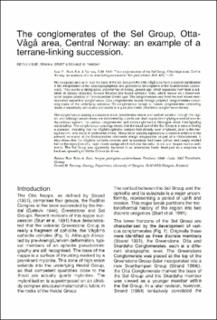| dc.contributor.author | Bøe, R. | |
| dc.contributor.author | Ramsay, D.M. | |
| dc.contributor.author | Sturt, B.A. | |
| dc.coverage.spatial | SEL | |
| dc.coverage.spatial | VÅGÅ | |
| dc.coverage.spatial | 16181 Vågå | |
| dc.coverage.spatial | 17184 Otta | |
| dc.date.accessioned | 2020-08-26T09:13:05Z | |
| dc.date.available | 2020-08-26T09:13:05Z | |
| dc.date.issued | 1993 | |
| dc.identifier.uri | https://hdl.handle.net/11250/2674277 | |
| dc.description.abstract | The conglomerates at or near the base of the Sel Group in the Otta-Vågå area have a special significance in the interpretation of the palaeogeographical and geotectonic development of the Scandinavian Caledonides. They overlie a stratigraphic unconformity of Arenig-Llanvirn age, which separates them from a substrate of already obducted, forward-thrusted and folded ophiolitic rocks, which repose on a basementcover coupled possibly of Fennoscandian Shield type. The conglomerates vary from the well known nearmonomict serpentine conglomerate (Otta conglomerate facies) through polymict conglomerates containing clasts of the underlying substrate (To conglomerate facies) to mature conglomerates con- taining clasts of essentially vein quartz and quartz in a quartzitic matrix (Skardshøi conglomerate facies). The conglomerate-bearing successions show considerable lateral and vertical variation through the region, and although certain areas are dominated by a particular clast population implying a special source-depositional system, the various conglomeratic and non-conglomeratic lithologies show interdigitat- ing relationships. The conglomerate petrology shows that the basal part of the Sel Group is a terrane-linking succession, indicating that the Vågåmo ophiolite complex had already been emplaced, prior to the Arenig\/Llanvirn, onto rocks of continental affinity. These latter possibly represented a western (relative to the present) extension of the Baltoscandian continental margin miogeocline, or part of a microcontinent. It also shows that the Vågåmo ophiolite complex, and its substrate had been uplifted and deeply eroded before the deposition of a major clastic wedge which includes fan delta, littoral and deeper marine sedi- ments. The Sel Group was apparently deposited in an extensional basin developed as a response to back-arc spreading in Middle Ordovician times. | |
| dc.language.iso | eng | |
| dc.relation.ispartofseries | NGU Bulletin (425) | |
| dc.rights | Navngivelse 4.0 Internasjonal | |
| dc.rights.uri | http://creativecommons.org/licenses/by/4.0/deed.no | |
| dc.subject | SEDIMENTOLOGI | |
| dc.subject | AVSETNINGSMILJØ | |
| dc.subject | PETROGRAFI | |
| dc.subject | STRATIGRAFI | |
| dc.subject | TEKTONIKK | |
| dc.subject | STRUKTURGEOLOGI | |
| dc.subject | KILDEOMRÅDE (SEDIMENTOLOGI) | |
| dc.title | The conglomerates of the Sel Group, Otta-Vågå area, Central Norway: an example of a terrrane-linking succession | |
| dc.type | Journal article | |
| dc.description.localcode | 35879 | |
| dc.source.pagenumber | 1-23 | |

